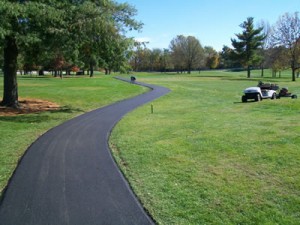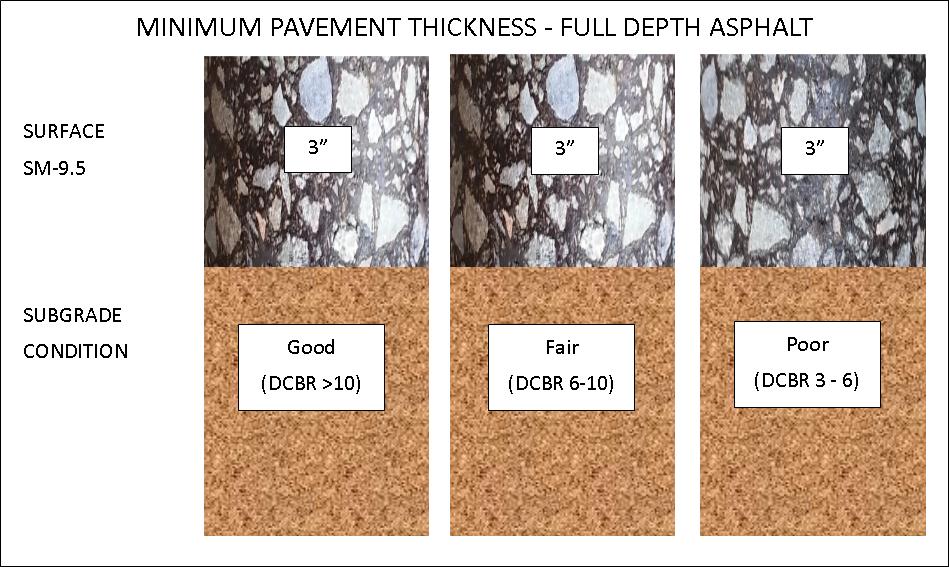 Please note: The following information on the design, construction, and maintenance of bicycle trails and golf cart paths is intended as a general guide on basic techniques. Due to the multitude of designs and applications, individual pavement structure details discussed here are limited.
Please note: The following information on the design, construction, and maintenance of bicycle trails and golf cart paths is intended as a general guide on basic techniques. Due to the multitude of designs and applications, individual pavement structure details discussed here are limited.
Design Limitations and Special Requirements
Bicycle trails and pathways are generally constructed in much the same manner as asphalt paved sidewalks. However, they are usually built wide enough to permit one vehicle to safely pass another (8 feet). Golf cart paths  require the same pavement thickness as bike paths and a minimum pavement width of five feet (5′). In remote areas, difficult terrain or where damage to grounds may occur, consideration should be given to constructing the pavements to widths that will accommodate maintenance and emergency vehicles. The pavements are not usually designed to withstand repeated loads from these types of vehicle but an occasional load application can be made without undue damage. Additional widening on sharp curves is also recommended as a safety measure. To minimize golf shoe spike wear where hard spikes are permitted, the pavement should be designed with a higher than normal asphalt content.
require the same pavement thickness as bike paths and a minimum pavement width of five feet (5′). In remote areas, difficult terrain or where damage to grounds may occur, consideration should be given to constructing the pavements to widths that will accommodate maintenance and emergency vehicles. The pavements are not usually designed to withstand repeated loads from these types of vehicle but an occasional load application can be made without undue damage. Additional widening on sharp curves is also recommended as a safety measure. To minimize golf shoe spike wear where hard spikes are permitted, the pavement should be designed with a higher than normal asphalt content.
It is desirable to lend the surface of the pavement to the contour of existing ground for aesthetics and so that surface drainage runs over it or away from it in its natural course.
Traffic Considerations
Non-motorized vehicles, golf carts, and the occasional maintenance truck is the primary traffic on most paths. These vehicles do not normally cause pavement damage. At times, a heavy truck may use the path. These heavy trucks could damage a path, especially if the subgrade is saturated. If these trucks must use the path, it is recommended to wait until a time of the year when the pavement and soil are either dry or frozen.
Subgrade Preparation
Because the subgrade must serve both as a working platform to support construction equipment and as the foundation for the pavement structure, it is most important to see that the subgrade is properly compacted and graded. A visual examination will usually reveal the adequacy of elevation. However, laboratory tests to evaluate the load-supporting characteristics of subgrade soil are desirable. If these tests are not available designs may be chosen based on careful field evaluations and previous projects and experience in the area.
All underground utilities should be protected or relocated prior to grading. All topsoil should be removed and low-quality soil must be improved by adding asphalt or other suitable admixtures such as lime or granular materials. The areas to be paved should be treated with a soil sterilant to inhibit future flora growth after all rock, debris and vegetation matter have been removed. Grading and compaction of the area should be completed in such a manner as to prevent yielding areas or pumping of the soil (A large truck driven over the area will give an indication of any “soft spots”). Should a weak spot be discovered, the material should be removed and replaced with either six inches (6″) of compacted crushed stone or three inches (3″) compacted asphalt concrete. In case of extremely poor subgrade, it may be necessary to remove the upper portion of the subgrade and replace it with the selected material. When finished, the graded subgrade should not deviate from the required grade and cross section by more than one-half inch (1/2”) in ten feet (10′).
Drainage Provisions
 It is most important to keep water away from the subgrade soil. If the soil becomes saturated it will lose strength and stability and make the overlying pavement structure susceptible to break up under imposed loads. Both surface and subsurface drainage must be considered. All drainage must be carefully designed and should be installed in the construction process as early as is practicable. Bicycle and golf cart paths should follow the contour of the terrain so that surface water runs off the pavement and away from it. Flat bicycle and golf cart paths should have a minimum slope of two percent (2%) or one-quarter inch (1/4″) per foot (1 ‘) and be constructed in such a manner that water will not collect at the pavement edge. Areas of very high natural permeability may require an under-drain system to carry water away from the pavement structure. Note: underdrains are usually not necessary when asphalt concrete is used for the base and surface courses.
It is most important to keep water away from the subgrade soil. If the soil becomes saturated it will lose strength and stability and make the overlying pavement structure susceptible to break up under imposed loads. Both surface and subsurface drainage must be considered. All drainage must be carefully designed and should be installed in the construction process as early as is practicable. Bicycle and golf cart paths should follow the contour of the terrain so that surface water runs off the pavement and away from it. Flat bicycle and golf cart paths should have a minimum slope of two percent (2%) or one-quarter inch (1/4″) per foot (1 ‘) and be constructed in such a manner that water will not collect at the pavement edge. Areas of very high natural permeability may require an under-drain system to carry water away from the pavement structure. Note: underdrains are usually not necessary when asphalt concrete is used for the base and surface courses.
Base Construction (Asphalt)
 Prior to placement of the asphalt concrete base course, the subgrade should be graded to the established requirements, adequately compacted, and all deficiencies corrected. The asphalt concrete base course should be placed directly on the prepared subgrade in one or more lifts, spread, and compacted to the pavement thickness indicated on the plans or established in the contract. (Compaction of asphalt mixtures is one of the most important construction operations contributing to the proper performance of the completed pavement, regardless of the thickness of the course being placed. This is why it is so important to have a properly prepared subgrade against which to compact the overlying pavement.) The asphalt concrete should meet the Virginia Department of Transportation specifications for the mix type specified.
Prior to placement of the asphalt concrete base course, the subgrade should be graded to the established requirements, adequately compacted, and all deficiencies corrected. The asphalt concrete base course should be placed directly on the prepared subgrade in one or more lifts, spread, and compacted to the pavement thickness indicated on the plans or established in the contract. (Compaction of asphalt mixtures is one of the most important construction operations contributing to the proper performance of the completed pavement, regardless of the thickness of the course being placed. This is why it is so important to have a properly prepared subgrade against which to compact the overlying pavement.) The asphalt concrete should meet the Virginia Department of Transportation specifications for the mix type specified.
Base Construction (Aggregate)
The subgrade must be graded to the required contours and grade in a manner that will ensure a hard, uniform, well-compacted pavement structure. All subgrade deficiency corrections and drainage provisions should be made prior to constructing the aggregate base. The crushed aggregate base course should consist of one or more layers placed directly on the prepared subgrade, spread and compacted to the uniform thickness and density as required on the plans or established by the owner. Absolute minimum crushed aggregate thickness is four inches (4″). All crushed aggregate material should be of Virginia Department of Transportation approved type and suitable for this type of application.
Tack Coat (if needed)
Prior to placement of successive pavement layers, the previous course should be cleaned and, if needed, a tack coat of diluted emulsified asphalt applied. The tack coat may be eliminated if the previous course is freshly placed and thoroughly clean.
Asphalt Surface Course
Material for the surface course should be asphalt concrete placed in one (or more) lifts to the true line and grade as shown on the plans or set by the owner. Bicycle and golf cart paths are generally placed in one lift, therefore making it impractical to use more than one asphalt mix type. Also, such pavements carry no vehicular traffic, making thicknesses greater than minimum requirements unnecessary.
The bituminous concrete material should conform to Virginia Department of Transportation specifications for asphalt concrete. Any irregularities in the surface of the pavement course should be corrected directly behind the paver. Rolling and compaction should start as soon as the material can be compacted without displacement and continued until thoroughly compacted and all roller marks disappear.
Pavement Structure and Materials
The pavement structure and materials are common across subgrade strengths and construction approaches. Some projects will use full-depth asphalt (i.e., asphalt placed directly on compacted subgrade) and some will use an aggregate base placed on compacted subgrade. The aggregate base will be covered with one or more layers of asphalt. The table below is the minimum pavement designs. Each layer is the compacted thickness. At no time should less than 4 inches of an aggregate subbase layer be used. In addition, most owners will not have a soil strength test performed on their subgrade. Therefore, for silty and clayey soils, a medium or weak subgrade should be assumed. For sandy and gravelly/rocky subgrade, a strong or medium subgrade should be assumed.
Table 1 – Full-Depth Asphalt Pavement
Table 2 –Asphalt with Aggregate Sub-Base Pavement
Notes:
- SM-9.5 is a common mix for most asphalt producers. However, some producers may have an SM-4.75, SM-9.0 or SM-12.5 available as well. Contact your local asphalt producer to discuss which asphalt surface mixes are available.
- The 3-inch surface is placed in one lift and not multiple lifts due to constructability
- Design CBR (DCBR) is defined as 2/3 of the soaked CBR value.
- VDOT Specifications for SM-4.75, SM-9.0, SM-9.5, and SM-12.5 can be found in Section 211 of the 2016 VDOT Road and Bridges Specification Book.
- VDOT Specifications for 21A and 21B can be found in Section 208 of the 2016 VDOT Road and Bridges Specification Book.
References
2016 VDOT Road and Bridges Specifications
2016 VDOT Special Provisions to the Road and Bridges Specifications

